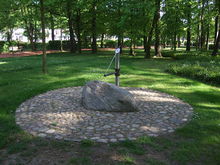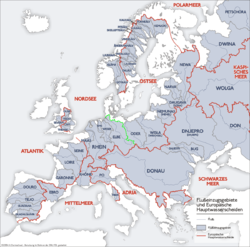North Sea-Baltic Sea Divide
The Central European North Sea and Baltic Sea watershed cuts through northern, eastern and central Germany, while in northwest-southeast direction the country Schleswig-Holstein , Mecklenburg-Western Pomerania , Brandenburg and Saxony passes. It leads from Sydjylland through the aforementioned German areas to the Czech Republic .
Catchment areas
Waters towards the west flow into the North Sea , towards the east into the Baltic Sea .
course
The Central European North Sea-Baltic Sea watershed leads in Germany from the border with Denmark at Harrislee in southeastern directions via fishing, the Danish Wohld, Kiel, the Lauenburg Lakes Nature Park, the Schaalsee Biosphere Reserve, the Mecklenburg Lake District, the Uckermark, the Barnim Nature Park, the Märkische Schweiz Nature Park, the Berlin Glacial Valley, the Schlaubetal Nature Park, the Muskau Arch, the Muskau Heath, the Königshain Mountains, and across the Lusatian Mountains to the Czech border near Neugersdorf. On the ridge of the Zittau Mountains, it touches German territory again and then continues through the Czech Republic.
Course of the North Sea-Baltic Sea watershed from northwest to southeast:
- Harrislee
- Flensburg
- Fishing :
- Mohrkirch
- Schuby
- Hüttener Mountains
- Danish welfare :
- Kiel , Kronshagen
- Trappenkamp
- Wahlstedt
- Near
- Elmenhorst
- Bargteheide
- Stone castle
- Lauenburg Lakes Nature Park :
- Schaalsee biosphere reserve
- Lützow
-
Mecklenburg Lake District :
- direct western, northern and eastern surroundings of the Schweriner See with Wittenförden , Schwerin , Bad Kleinen and Leezen , western surroundings of the Pinnower See , Sukow , western surroundings of the Plauer See , nature park Nossentiner / Schwinzer Heide with Karow and Hohen Wangelin , nature park Mecklenburgische Schweiz and Kummerower Lake , Müritz National Park , northern surroundings of Neustrelitz , Feldberger Seenlandschaft nature park
- Uckermark :
- Barnim Nature Park
- Märkische Schweiz nature park
- western area of Frankfurt (Oder) ( Land Lebus )
- Berlin glacial valley
- western surroundings of Eisenhüttenstadt
- Schlaubetal Nature Park
- Muskauer fold arch
- Muskauer Heide
- Landeskrone (west of Görlitz)
-
Lusatian highlands :
- Kottmar , Neugersdorf on the Czech border
- Zittau Mountains
Examples
- Schwentine and Eider arise at the Großer Plöner See and flow to the Kiel Fjord . The Hornheimer Riegel pushes the Eider west to the North Sea.
- While the Schaale , which flows from the southern part of the Schaalsee ( Mecklenburg ) near Zarrentin , turns south over the Sude and Elbe to the North Sea, the Maurine , which rises north of the Schaalsee near Carlow , flows north over the Stepenitz and Trave into the Baltic Sea.
- While the Havel , which rises in Mecklenburg west of Neustrelitz, turns first in a southerly direction and then mainly to the west over the Elbe towards the North Sea, the Tollense , which rises a little further east, flows in a northerly direction over the Peene into the Baltic Sea.
- While the short streams that arise in the Uckermark in the western part of the Schorfheide-Chorin Biosphere Reserve turn westwards over the Havel and Elbe to the North Sea, the Ucker , which rises in the northern part of the Schorfheide in the municipality of Temmen-Ringenwalde , flows north into the Stettiner Haff and thus into the Baltic Sea.

- The North Sea-Baltic Sea watershed between Wandlitzer See and Liepnitzsee runs through Wandlitz . The Wandlitzer See is the source lake of the Briese , which flows into the North Sea via the Havel and Elbe . The Liepnitzsee is one of the source lakes of the Finow , which flows over the Oder into the Baltic Sea.
- The river Stöbber flows from the Roten Luch , where it rises as a standing watercourse, at the same time to the east over the Oder into the Baltic Sea and to the west over the Spree, Havel and Elbe into the North Sea without branching out.
- While the Spree , which rises in Saxony in the Lausitzer Bergland in the Neugersdorf area, turns north over the Havel and Elbe to the North Sea, the Mandau , which rises a little further west in Czech territory, flows east over the Lausitzer Neisse and the Or in the Baltic Sea.
